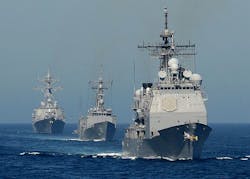Officials of the Office of Naval Research (ONR) in Arlington, Va., issued a sources-sought notice (N00014-17-RFI-0005) last week for the Panoramic Imaging for Situational Awareness and Target Recognition project.
Researchers are trying to blend coarse- and high-resolution imagery from passive sensors such as long-, mid-, and short-wave infrared (SWIR) detectors -- perhaps even passive millimeter wave technology -- to help ship crews quickly detect, locate, and defend against surface and airborne threats such as fast-attack boats and anti-ship missiles.
Navy experts not only are interested in blending coarse- and high-resolution imagery, but also in blending data from different kinds of sensors to make the most of target detection in clouds, dust, fog, and rain.
For this project Navy experts are focusing on a field of view measuring 20 degrees below the horizon of a surface ship, to 30 degrees above the ship's horizon. The object is to make the most efficient use possible of sensors and signal-processing, yet still meet the Navy's situational-awareness requirements for surface ships.
Today the Navy uses two different approaches to shipboard situational awareness using electro-optical sensors: medium resolution and coarse resolution.
Medium resolution of around 80-microradian instantaneous field of view imaging sensors are able to see to 50 degrees above the horizon, and can provide 360 degree coverage. Coarse-resolution sensors of around 100 to 200 microradian instantaneous field of view, meanwhile, can work quickly enough to detect fast-moving threats.
Cues from coast-resolution sensors can steer high-resolution sensors with narrow fields of view video-frame-rate imaging sensors to help recognize, identify, track, and gauge the intent of nearby threats.
Each of these solutions has drawbacks, Navy researchers say. Medium-resolution imaging sensors reduce the revisit rate for detected targets, and can miss fast-moving targets and generate too many false alarms.
Related: EO/IR sensors boost situational awareness
Coarse-resolution sensors, meanwhile, maintain situational awareness at frame rates fast enough to track fast-moving targets, deal with clutter, and reduce false-alarm rates, yet are not effective in the presence of targets numbering in the tens or hundreds. This approach also has latency issues as the high-resolution imager slews from one contact to another.
Instead, Navy researchers are asking industry for unconventional approaches, such as one that provides a coarse-resolution staring mode for situational awareness, while simultaneously under software control providing more than 100 regions that obtain high-resolution and video-frame-rate images. These regions also should be able to be steered dynamically without mechanical motion to follow objects of interest.
By providing high resolution only over regions of interest, such a system will minimize the data transfer bandwidth as well as size, weight, power consumption, and cost (SWaP-C) of the overall system, Navy researchers say.
This project also seeks to identify a family of imaging systems that could handle the situational-awareness needs of surface vessels ranging in size from a patrol craft, a frigate, a destroyer, and an aircraft carrier.
Related: Navy to evaluate 360-degree imaging system to enhance submarine situational awareness
Navy researchers are looking for information from industry that is grounded in sound physical principles, and that is consistent with technology-development roadmaps in optics, focal plane arrays, and image processing hardware and algorithms.
Email responses in .pdf format no later than 6 Oct. 2017 to the Navy's Ravi Athale at [email protected]. Put “Panoramic Imaging for Situational Awareness” in the subject line.
Email questions or concerns to Ravi Athale at [email protected]. Email business questions to AnShawn Lewis at [email protected].
More information is online at https://www.fbo.gov/spg/DON/ONR/ONR/N00014-17-RFI-0005/listing.html.
Learn more: search the Aerospace & Defense Buyer's Guide for companies, new products, press releases, and videos



